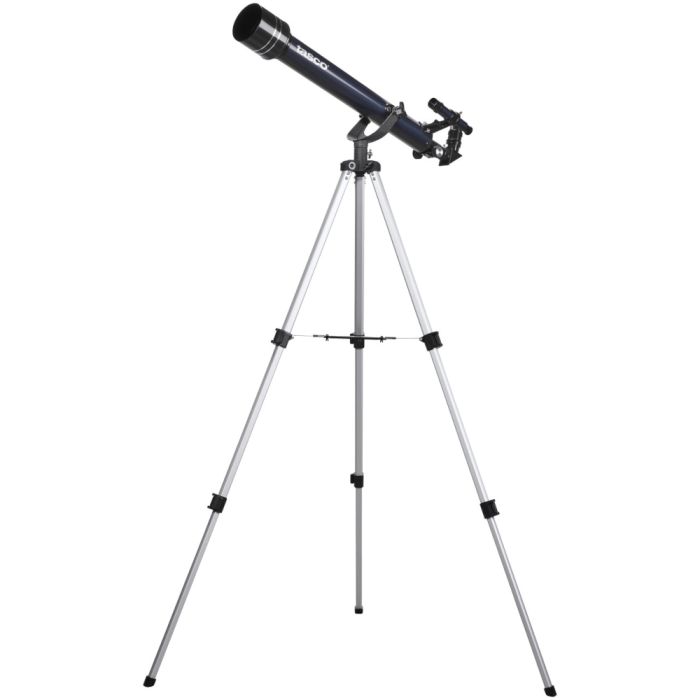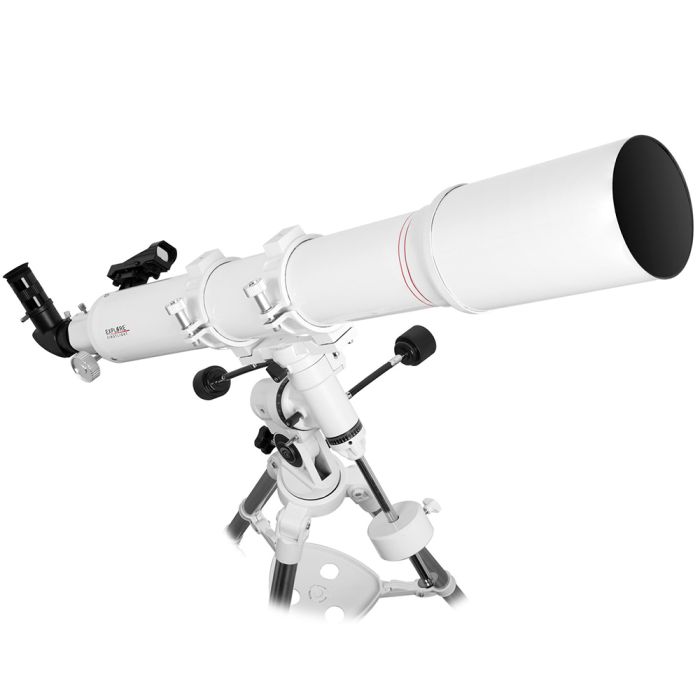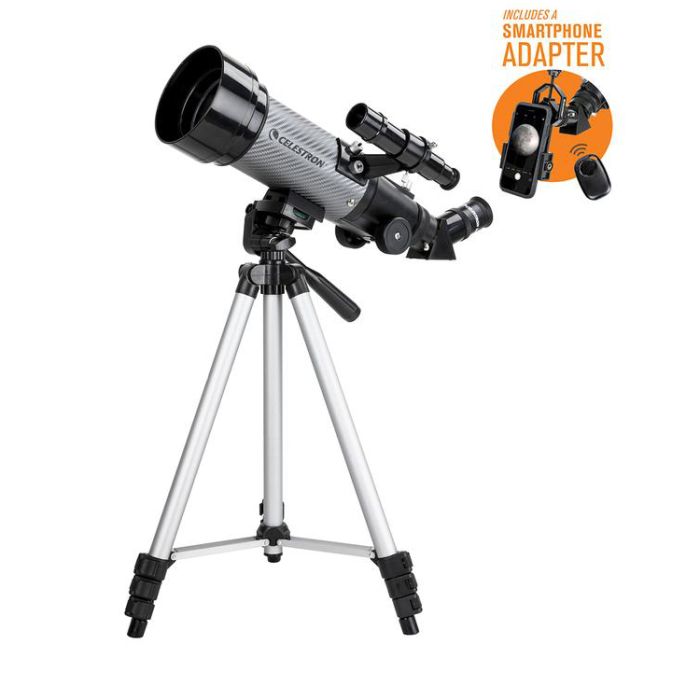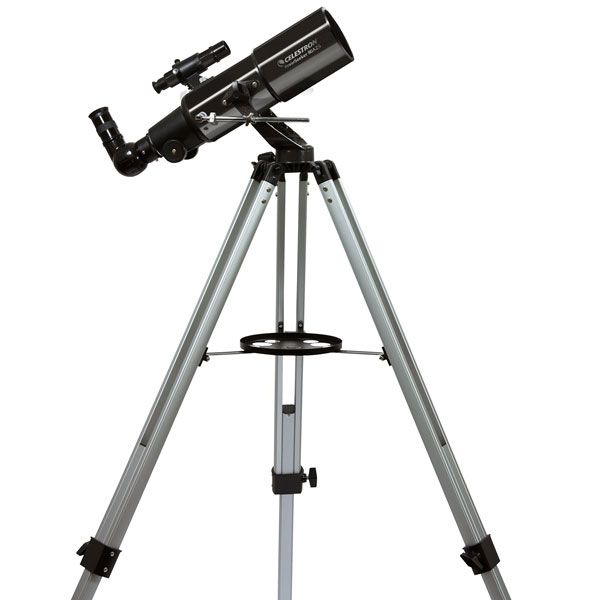
Astronomers often use refractor telescopes on non-computerized mounts, like the Altazimuth, Equatorial, and Manual Dobsonian mounts, for hand correction, pole alignment, and terrestrial viewing. The Askar SQA106 Quintuplet Refractor is the best example, with a telescopic aperture of 106mm (4.17") and a focal ratio of f/4.8.
Highlighted Products
Featured Product 1
href="https://www.highpointscientific.com/celestron-travel-scope-70-dx-portable-telescope-with-smartphone-adapter-22035">Celestron's Travel Scope 70 DX is a versatile day-to-night telescope with an adjustable tripod, smartphone adapter, and smartphone adapter, conveniently packed into a custom backpack for portability, offering stunning views of planets and the moon.
Featured Product 2
An alternative that is quality and versatile is the Celestron PowerSeeker 80AZS system and other similar models. These telescopes have powerful alt-azimuth mounts that provide clear views and are simple to set up and use.
Featured Product 3
For those looking for even more advanced features and technology and noteworthy option is the Celestron StarSense Explorer DX 102AZ Refractor Telescope. It is a smartphone-based astronomy system that connects to a telescope via a StarSense dock, offering precise aiming instructions and star pattern data collection through a specially designed mirror.
More About This Category
Astronomy Observers have also used reliable and conservative refractor telescopes on non-automatic platforms. These telescopes gather light using lenses and then fold it to produce highly brilliant, precisely defined images of things in space, including the moon, the planets, and the double stars. From a maintenance standpoint, refractor telescopes are renowned for being low-profile.
Dust and dirt can concern open-design reflectors since the optical path is exposed. However, reflectors typically have no moving components in their optical system, making collimation straightforward and the maintenance of refractors simple and logical.
Maintenance of refractor telescopes on non-computerized bases is easy. The most important task is keeping the optical surfaces pristine. Although the lenses are enclosed, cleaning is not as necessary; however, using appropriate lens cleaning solutions and techniques to avoid glass damage when needed is essential. Frequent inspections of the mount's mechanical components—such as lubricating moving parts and tightening bolts—will guarantee perfect functioning and increase equipment lifetime.
Open-design telescope reflectors present a significant challenge as the optical path is enclosed, and one will not be disturbed by dirt or dust gathering within buildings. The optical system lacks moving components, suggesting that collimation—the centering of the optics—is superfluous; refractors are solid and easy to maintain.
Refractor telescopes on non-computerized mounts often focus on their simplicity of operation, image quality, and suitability for various types of observation. Common questions include:
1. Are novices suited for refractors?
Indeed, refractors are great for beginners because of their low maintenance needs and simplicity of usage. Their simple setup and robust design make them less prone to required changes.

The Tasco Novice 60mm Refractor Telescope and 1200X Microscope & Accessories boast a 2x Barlow lens, finderscope, straightforward construction, and a full-size tripod. The microscope's up to 1200x magnification gives up-close, personal views of things on slides. Slide covers, dyes, and other basics comprise the 19-piece accessory kit. Children and beginners will find this reasonably priced telescope and microscope combo ideal.
A refractor telescope on a non-computerized mount can view the Moon, planets, and double stars even if its field of view is less. Track objects without a computerized mount by hand, adjusting either one axis on an equatorial mount or both on an alt-azimuth mount.
2. How do alt-azimuth and equatorial mounts differ?
Alt-azimuth and equatorial mounts are simple celestial object tracking systems, while computerized mounts with GoTo systems offer convenience but require power sources and can be complex to set up. Non-computerized mounts emphasize manual and traditional aspects of stargazing, providing a more immersive and educational experience. Both types of mounts offer a unique perspective on celestial objects.
Appropriated for both terrestrial and celestial viewing, the AstroMaster Series 70mm refractor telescope is an alt-azimuth dual-purpose telescope. It generates clear pictures of the Moon and planets and offers correct perspectives of land and heavens.
Featuring a 102mm aperture and doublet design for chromatic aberrations, Explore Scientific FirstLight refractor and equatorial mount is a robust configuration for solar system and deep sky viewing. Designed as a light-duty German equatorial mount with slow-motion settings, the EXOS EQ Nano Mount lets users follow objects in the night sky.


Refractor telescopes' simplicity and dependability help explain their value on non-computerized mounts. They offer a user-friendly experience for individuals who appreciate the hands-on nature of astronomy. Users can set up and start watching rapidly without regard to power sources or alignment techniques linked with computerized mounts. This immediacy benefits unplanned meetings and individuals who would rather stargaze using a more conventional, tactile method. Refractors also offer straightforward, contrast-rich images, making them especially appropriate for planetary studies where clarity and detail are critical.


